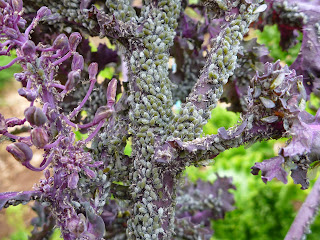Aphids under Attack
I thought I would share this really interesting photo showing biological warfare being carried out on my plot at an almost microscopic level.
The plant is a Red Curled Kale which has bolted and I was in the process of chopping up for the compost heap. It has been infested with aphids which have acquired a slightly purple tinge themselves from eating the plant. Look closer however (click on the image to enlarge), and you will spot a number of lacewings happily munching through the aphid colony.
On the far left you can also see what look like skeletal remains, but which we think are the out-grown skins of aphids which have grown rapidly and shed their skins - presumably in order to eat more kale.
Lacewing larvae are also voracious feeders of aphids so it is a good idea to attract lacewings onto your plot or garden. The best way to do this is to give them somewhere to over-winter - a bug house is ideal, but a pile of rotted logs may suffice. In the summer you can attract them by growing sunflowers, cosmos, dill and yarrow - these will attract beneficial ladybirds too.
Once they have found an aphid colony the female lacewings lay their eggs (over 400 each) and their larvae, which are also known as 'Aphid Lions,' eat up to 600 aphids in the time it takes them to mature. As with ladybirds, if you spray your crops with pesticides you will kill the lacewings too.
The plant is a Red Curled Kale which has bolted and I was in the process of chopping up for the compost heap. It has been infested with aphids which have acquired a slightly purple tinge themselves from eating the plant. Look closer however (click on the image to enlarge), and you will spot a number of lacewings happily munching through the aphid colony.
On the far left you can also see what look like skeletal remains, but which we think are the out-grown skins of aphids which have grown rapidly and shed their skins - presumably in order to eat more kale.
Lacewing larvae are also voracious feeders of aphids so it is a good idea to attract lacewings onto your plot or garden. The best way to do this is to give them somewhere to over-winter - a bug house is ideal, but a pile of rotted logs may suffice. In the summer you can attract them by growing sunflowers, cosmos, dill and yarrow - these will attract beneficial ladybirds too.
Once they have found an aphid colony the female lacewings lay their eggs (over 400 each) and their larvae, which are also known as 'Aphid Lions,' eat up to 600 aphids in the time it takes them to mature. As with ladybirds, if you spray your crops with pesticides you will kill the lacewings too.
Submitted by Jane, plot 9

Comments
Post a Comment